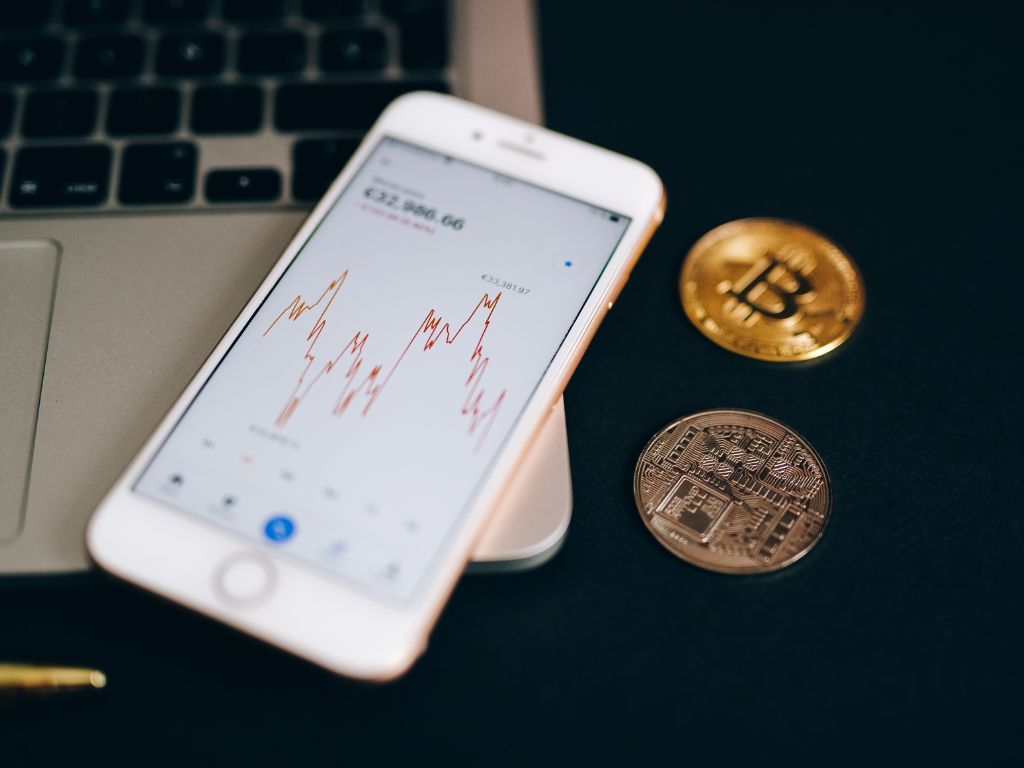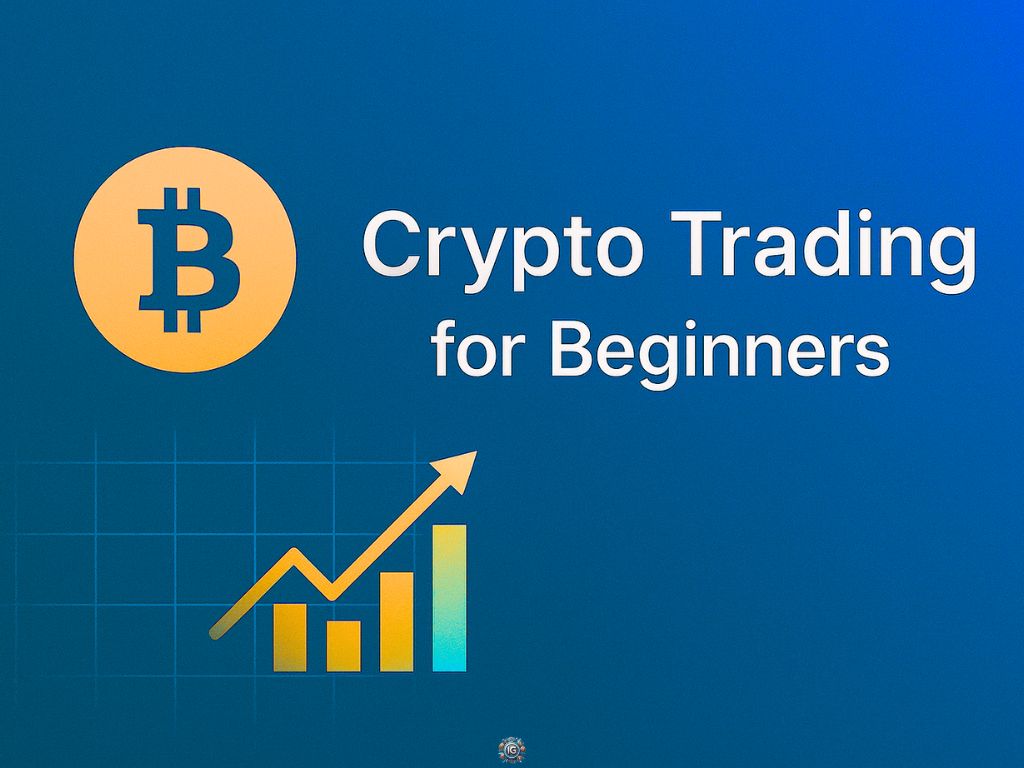Introduction
Crypto trading for beginners in 2025 is no longer a fringe hobby for tech-savvy insiders — it’s a global opportunity for anyone looking to grow wealth, diversify income, or take control of their financial future.
But with that opportunity comes confusion. Between the nonstop headlines, volatile markets, and complex platforms, knowing where to start can feel overwhelming.
The good news? You don’t need a finance degree or thousands of dollars to get started. All you need is a simple strategy, the right tools, and the willingness to learn.
This guide is built specifically for beginners who want to enter the crypto market with clarity, confidence, and smart risk management.
You’ll discover how trading really works, which mistakes to avoid, and how to go from your first deposit to your first profitable trade — all without getting lost in technical jargon or hype.
By the end, you’ll understand not just how to trade crypto, but how to trade it wisely. Because in 2025, the smartest traders aren’t chasing quick wins — they’re building long-term success one educated trade at a time.
Key Takeaways
- Crypto trading is the short-term buying and selling of digital assets like Bitcoin to profit from price changes.
- Beginners should start with a small investment, learn how exchanges work, and practice using demo or spot accounts.
- Choosing a secure and beginner-friendly exchange is critical for safe trading.
- Technical and fundamental analysis help traders make informed decisions instead of guessing.
- Risk management tools like stop-loss and take-profit orders are essential to protect your funds.
- Success in crypto trading comes from strategy, patience, and consistent learning — not hype or emotion.

What Is Crypto Trading & How Does It Work?
Crypto trading is the act of buying and selling digital currencies — like Bitcoin, Ethereum, or Solana — with the goal of making a profit. Unlike traditional investing, which focuses on long-term holding, crypto trading is more active and often short-term. Traders try to take advantage of price movements that can happen over hours, days, or weeks.
The market is open 24/7, which means opportunities and risks never stop. You don’t need a broker or a bank to get started. Instead, you’ll use a cryptocurrency exchange — an online platform that lets you buy, sell, and swap coins directly. Some of the most popular exchanges for beginners include Binance, Coinbase, and Kraken.
The basic process looks like this: you deposit money (called fiat currency like USD or EUR) into your exchange account, pick a trading pair like BTC/USDT, and then place your trade. When you buy, you’re betting that the price will go up. When you sell, you’re either taking profits or cutting a loss — both are part of the game.
Behind every smart trade is a strategy. Beginners often start by learning basic chart patterns and indicators to spot when prices might rise or fall. Others focus on news and events that move the market, like regulations or new coin launches. Over time, you’ll develop your own style — but it all starts with understanding how the system works.
Crypto trading isn’t gambling, and it’s not magic. It’s a skill. And the more time you spend learning how it works, the faster you’ll be able to recognize good opportunities and avoid common mistakes.
Crypto Trading vs. Stock Trading
If you’re familiar with stock trading, crypto might seem similar at first — both involve buying low and selling high. But the differences between them are big enough to impact how you approach each market.
The most noticeable difference is that crypto markets never close. While stock markets operate on set hours and close on weekends, crypto trades 24/7. This non-stop nature means opportunities are always available — but so are risks, especially when you’re not watching the market.
Another key distinction is regulation. Stock markets are heavily regulated by government agencies like the SEC. Crypto markets, on the other hand, are still evolving and often lack clear oversight, especially across different countries. This makes crypto more flexible, but also riskier if you’re not cautious.
When it comes to volatility, crypto tends to move faster and with more intensity. A stock might fluctuate by 1–2% in a day. A cryptocurrency can swing 10% or more in a single hour. That volatility creates huge opportunities — and huge risks — for traders.
Accessibility is also different. To trade stocks, you often need a brokerage account tied to your identity and country. In crypto, all you need is an internet connection and a crypto wallet. Some decentralized platforms don’t even require ID, giving anyone in the world the chance to participate.
Here’s how they stack up side-by-side:
| Feature | Crypto Trading | Stock Trading |
| Market Hours | 24/7 | Weekdays, 9 AM–5 PM |
| Volatility | High | Moderate |
| Regulation | Light / Evolving | Strict / Government-led |
| Accessibility | Global, few restrictions | Often region-locked |
| Ownership | Digital assets | Equity/shares in companies |
| Settlement Speed | Instant or minutes | T+2 days (standard) |
Understanding these differences helps you approach crypto with the right mindset. It’s faster, more volatile, and more open — which is why strategy and discipline matter more than ever.
Common Myths About Crypto Trading
When you’re new to crypto trading, it’s easy to get caught up in myths that either scare you away or give you a false sense of confidence. The truth is more balanced — and understanding it will help you trade with clarity instead of confusion.
Myth 1: You Need to Be a Tech Genius
One of the biggest misconceptions is that crypto trading is only for programmers or blockchain experts. In reality, many exchanges are designed for everyday users with simple dashboards, one-click trades, and built-in guidance. If you can shop online, you can learn to trade crypto.
Myth 2: It’s Easy Money
Yes, people have made life-changing profits in crypto. But what you don’t always see are the losses behind the scenes. Crypto trading can be profitable, but it’s not a guaranteed win. Without a strategy and risk management, you’re not trading — you’re gambling.
Myth 3: You Need Thousands of Dollars to Get Started
You don’t need to buy a whole Bitcoin to begin trading. Most platforms let you trade fractions of a coin — sometimes for as little as $10. Starting small is actually the smartest way to learn, because it gives you room to make mistakes without heavy losses.
Myth 4: You Have to Watch the Market All Day
While some advanced traders monitor price action minute-by-minute, that’s not the only way to trade. You can use tools like limit orders, stop-losses, and mobile alerts to stay in control without being glued to your screen.
Myth 5: Crypto Is Just a Fad
After more than a decade of growth, innovation, and global adoption, crypto is no longer a trend — it’s a growing financial ecosystem. Governments are drafting policies, institutions are investing billions, and developers are building real-world applications every day. Trading crypto today is like trading tech stocks in the early 2000s — risky, yes, but full of potential.
Breaking through these myths is the first step toward becoming an informed, strategic trader. And the better you understand the truth, the stronger your foundation for future growth.

Types of Crypto Trading Strategies
Not all crypto traders operate the same way. Some look for quick wins within hours, while others hold positions for weeks, months, or even years. Understanding the main trading styles helps you pick the right strategy based on your lifestyle, risk appetite, and experience level.
Day Trading
Day traders buy and sell cryptocurrencies within the same day, aiming to profit from short-term price movements. It requires constant market monitoring, quick decision-making, and a solid grasp of technical analysis. While the potential gains are high, so is the risk — and it’s not ideal for someone who can’t dedicate full-time attention to the market.
Swing Trading
Swing trading involves holding positions for several days or weeks. Traders aim to capture “swings” in market momentum — buying low during dips and selling high as prices rise. It’s a popular strategy for beginners who can’t trade all day but still want to be actively involved.
Scalping
Scalping is about making many small profits from tiny price changes. These trades are executed in minutes, sometimes seconds. It demands speed, precision, and a reliable platform with low fees. For beginners, this is an advanced strategy best explored after gaining experience.
HODLing
The term “HODL” — originally a typo for “hold” — has become a long-term investing philosophy in the crypto world. HODLers buy a cryptocurrency they believe in and hold it regardless of market dips. It’s ideal for those who believe in the long-term value of crypto but don’t want to actively trade.
Arbitrage
This strategy takes advantage of price differences between exchanges. If Bitcoin is selling for $100 more on one platform than another, a trader might buy low on one and sell high on the other. While potentially profitable, arbitrage opportunities are rare and often require fast execution and larger capital.
Algorithmic Trading
Also known as bot trading, this strategy uses software to automate trading decisions based on pre-set rules. Bots can scan markets, place trades, and manage risk 24/7 — faster than any human. Beginners can explore basic bots, but it’s best used with strong foundational knowledge.
There’s no one-size-fits-all strategy. The best traders test different styles, find what suits their schedule and mindset, and refine their approach as they learn.

Spot Trading vs. Derivatives Trading
Before placing your first trade, it’s important to understand the difference between spot trading and derivatives trading. These two methods operate on very different principles — and the one you choose can dramatically affect your risk level and trading experience.
Spot Trading
Spot trading is the most straightforward way to trade crypto. You buy a cryptocurrency at the current market price — also known as the “spot price” — and you own it directly. If you buy 0.1 Bitcoin in a spot trade, that Bitcoin is yours, and you can hold it, transfer it to a wallet, or sell it at any time.
For beginners, spot trading is the safest place to start. It’s simple, transparent, and doesn’t involve borrowing money or betting on future prices. You can only lose what you put in, which makes it ideal for learning without taking on unnecessary risk.
Derivatives Trading
Derivatives trading is more complex. Instead of buying actual crypto, you trade contracts that represent the price of an asset. These include tools like futures, perpetual swaps, and options. Traders use derivatives to speculate on whether a coin will go up or down — often with borrowed money, also known as leverage.
With leverage, a small price move can lead to big profits — or big losses. For example, with 10x leverage, a 5% move against you can wipe out your entire position. That’s why derivatives are considered high-risk and best left to experienced traders who understand how to manage them.
Here’s how they compare:
| Feature | Spot Trading | Derivatives Trading |
| Asset Ownership | Yes | No (contract-based) |
| Complexity | Low | High |
| Leverage Involved | No | Yes (up to 100x or more) |
| Risk Level | Moderate | High |
| Best For | Beginners, long-term holders | Advanced traders, speculators |
If you’re just starting out, stick with spot trading. It’s safer, easier to understand, and gives you a direct feel for how markets move — without the pressure of leveraged losses.
Choosing the Best Crypto Exchange for Beginners
Before you can make your first trade, you’ll need to choose a cryptocurrency exchange — your trading platform and gateway into the crypto market. But not all exchanges are created equal. The one you pick can impact everything from your security to your success as a trader.
There are two main types of exchanges: centralized (CEX) and decentralized (DEX).
Centralized Exchanges (CEX)
Centralized exchanges are run by companies that act as middlemen in trades. Popular platforms like Coinbase, Binance, Kraken, and Crypto.com fall into this category. They offer easy sign-up, fiat-to-crypto conversions, mobile apps, customer support, and often educational tools — all of which make them ideal for beginners.
These platforms also offer high liquidity, which means trades happen fast and at fair market prices. However, they usually require KYC (Know Your Customer) verification — a process that involves uploading your ID to comply with financial regulations.
Decentralized Exchanges (DEX)
Decentralized exchanges like Uniswap, PancakeSwap, or SushiSwap allow users to trade directly from their wallets without signing up or handing over personal information. While this offers more privacy and control, DEXs typically have lower liquidity, no customer support, and a steeper learning curve. You’ll need to understand wallet connections, gas fees, and slippage before diving in.
What to Look For in a Beginner-Friendly Exchange
When you’re just starting out, focus on platforms that prioritize ease of use and strong security. Here’s what matters most:
- Security Features – Look for two-factor authentication (2FA), cold storage for funds, and regulatory compliance.
- User Interface – The dashboard should be clean, intuitive, and mobile-friendly.
- Supported Coins – Choose an exchange that offers the assets you want to trade or explore.
- Fees – Understand the trading, deposit, and withdrawal fees. They can vary widely.
- Customer Support – Fast, helpful support is critical when you’re learning the ropes.
- Educational Resources – Built-in learning tools can help shorten your learning curve significantly.
Best Exchanges for Beginners (2025 Snapshot)
- Coinbase – Great for first-timers; clean UI, high trust, higher fees.
- Binance – Offers advanced tools for growth, lower fees, massive coin variety.
- Kraken – Secure, regulated, and beginner-friendly with good customer support.
- Crypto.com – Easy mobile interface and cashback rewards for using their card.
Start with one exchange, master the basics, and expand only as your skill level grows. The right platform makes trading feel approachable — not overwhelming.

How to Start Trading Crypto (Step-by-Step Guide)
Getting started with crypto trading might feel intimidating at first, but the process is simple when broken down into clear steps.
Here’s how to go from zero to placing your first trade — safely and confidently.
1. Choose Your Exchange
Select a trusted, beginner-friendly platform like Binance, Coinbase, or Kraken. Make sure it supports your local currency and offers a solid mix of coins and security features.
2. Create and Verify Your Account
Sign up with your email address and set a strong password. Most centralized exchanges require identity verification (KYC), where you upload a government-issued ID and possibly a selfie for compliance. This step adds a layer of security to your account.
3. Deposit Funds
Once verified, you can deposit fiat currency (like USD or EUR) using bank transfers, credit cards, or other methods. Alternatively, you can transfer crypto from another wallet. Be aware of any deposit fees before confirming.
4. Choose a Trading Pair
A trading pair shows the asset you’re buying and what you’re using to buy it (e.g., BTC/USDT means you’re buying Bitcoin with Tether). Start with high-liquidity pairs like BTC/USDT or ETH/USD — they’re stable, well-supported, and easy to trade.
5. Place Your First Trade
Use the exchange’s basic trading interface to buy or sell. You can either:
- Use a market order to buy instantly at the current price.
- Use a limit order to set your own price and wait for the market to match it.
Market orders are faster and easier for beginners, but limit orders give you more control.
6. Set a Stop-Loss and Take-Profit (Optional but Recommended)
Protect your capital with stop-loss orders — automated triggers that sell your position if the price drops to a certain level. You can also set take-profit orders to automatically sell when you hit a desired profit.
7. Monitor and Adjust
Watch how your trade performs. Learn from what happens — whether it’s a gain or a loss. Each trade helps you improve. Use your exchange’s dashboard to track your portfolio, see price changes, and analyze your results.
8. Withdraw to a Secure Wallet (for Long-Term Holds)
If you’re not actively trading, move your crypto to a personal wallet (like a hardware wallet or mobile wallet) to reduce the risk of hacks. Exchanges are targets for cyberattacks, and long-term holdings are safest off-platform.
9. Keep Learning
Trading is a skill built through practice, education, and reflection. Use each experience to sharpen your judgment and refine your strategy.

Tools & Resources Every Crypto Trader Should Know
Successful crypto trading isn’t just about timing the market — it’s about using the right tools to analyze, manage, and protect your trades. In 2025, there’s no shortage of platforms and resources to help you trade smarter. Here are the essentials every beginner should know.
Crypto Exchanges
This is where your trading journey starts. Choose a platform with high security, low fees, and an interface that makes sense to you. As mentioned earlier, Binance, Coinbase, and Kraken remain the go-to choices for beginners.
Crypto Wallets
A crypto wallet is where you store your digital assets. While exchanges offer built-in wallets, serious traders move their assets to private wallets for more security. Use:
- Hot wallets (e.g., MetaMask, Trust Wallet) for short-term use or quick access.
- Cold wallets (e.g., Ledger, Trezor) for long-term storage and protection from hacks.
Charting Platforms
Reading charts is a fundamental trading skill. Platforms like TradingView let you track price movements, set alerts, and use indicators like RSI, MACD, or moving averages to spot trends.
Portfolio Trackers
Stay on top of your assets across multiple wallets and exchanges. Apps like CoinStats, Delta, or Blockfolio help you track your overall performance, set price alerts, and manage risk in real time.
Market Aggregators
Sites like CoinMarketCap and CoinGecko give you an overview of the market: coin rankings, historical price data, trading volume, and links to official resources — perfect for doing due diligence before jumping into a trade.
News & Sentiment Tools
Markets move on news. Use sites like Decrypt, CoinDesk, and The Block for updates. For social sentiment and on-chain data, try Santiment, LunarCrush, or CryptoQuant.
Education & Learning Hubs
To sharpen your skills, plug into ongoing education. Some of the best include:
- Binance Academy – Offers free lessons, glossaries, and tutorials.
- Coinbase Learn – Great for beginners, with interactive learning modules.
- YouTube Channels – Look for traders who explain strategies in plain English. Start with channels like “DataDash,” “Crypto Banter,” or “InvestAnswers.”
Bonus Tools for Advanced Beginners
As you grow, you might explore:
- Crypto tax tools (e.g., Koinly, CoinTracker)
- Bot platforms (e.g., 3Commas, Pionex)
- DeFi dashboards (e.g., Zapper, DeBank) for decentralized finance tracking
The key isn’t having every tool — it’s knowing which ones you need right now. Start simple, master one tool at a time, and build your own tech stack as your skills grow.

Risk Management for Beginners — How to Protect Your Capital
In crypto trading, managing your risk is just as important as picking the right coin. The market’s speed and volatility can wipe out an account just as quickly as it can grow one — which is why your first priority should never be profit, but protection.
Only Trade What You Can Afford to Lose
This rule sounds obvious, but it’s the first one beginners break. Never trade with rent money, savings you need next month, or anything you’d lose sleep over. Start small — even $20 is enough to practice with real emotion and learn from real results.
Use Stop-Loss Orders
A stop-loss is a trading tool that automatically closes your position if the price drops to a certain level. It protects you from catastrophic losses in fast-moving markets. Set your stop-loss below support zones or according to your personal risk threshold — not your emotions.
Follow the 1% Rule
A widely used strategy in trading is the 1% rule: never risk more than 1% of your total trading capital on a single trade. If your account is $1,000, you should not lose more than $10 per trade. This keeps your portfolio alive even if you go through multiple losses in a row — which every trader eventually does.
Avoid Overleveraging
Leverage lets you borrow funds to increase your trading position, but it also increases risk. While tempting, leverage is a double-edged sword. For beginners, it’s best to avoid it entirely until you’ve developed consistent risk-managed strategies.
Diversify Your Portfolio
Don’t put all your capital into a single coin — no matter how confident you feel. Even top cryptocurrencies can crash unexpectedly. Spread your trades across different assets to reduce the impact of a single failure.
Keep Emotions in Check
Fear of missing out (FOMO) and panic selling are two of the fastest ways to lose money. Set your entry and exit points before the trade, and don’t let excitement or anxiety override your plan. Crypto rewards patience and punishes impulsiveness.
Log Every Trade
Keep a trading journal where you record what you bought, why you bought it, how much you risked, and what the outcome was. Reviewing your trades helps you identify patterns, improve decisions, and avoid repeating mistakes.
Risk management isn’t just a strategy — it’s a mindset. The goal of trading isn’t just to win — it’s to stay in the game long enough to learn how to win consistently.

Best Courses and Learning Resources to Level Up Fast
Learning how to trade crypto isn’t a one-time event — it’s an ongoing process. The most successful traders aren’t just skilled; they’re students of the market. If you want to build consistency, confidence, and profit over time, continuous education is your edge.
Here are some of the best learning platforms and resources for beginners ready to take the next step.
Binance Academy
Free, well-structured, and beginner-friendly. Binance Academy offers hundreds of lessons on everything from blockchain basics to advanced trading strategies. It’s ideal for getting foundational knowledge directly from a top exchange.
Coinbase offers interactive tutorials and short videos for absolute beginners. Many lessons reward you with free crypto for completing them, which is a great bonus while learning how the system works.
Udemy: Crypto Trading Masterclass
This paid course covers trading tools, risk management, chart analysis, and real examples. It’s affordable and one of the most comprehensive options for structured learning in one place.
Coursera: Technical Analysis for Crypto
Offered by top institutions, Coursera courses dive deeper into reading charts, understanding market patterns, and making data-driven decisions — key for swing and day traders.
Investopedia Academy: Crypto Trading for Beginners
Backed by the well-known financial education site, this course combines traditional investing knowledge with practical crypto applications. It’s great for traders transitioning from stock markets.
YouTube Channels
If you prefer to learn visually and on-demand, YouTube has no shortage of content. Look for channels with transparent, educational content (not just hype). Recommended:
- DataDash – Market updates and trading psychology.
- Crypto Banter – News + real-time analysis.
- The Chart Guys – Pure technical analysis with trade breakdowns.
TradingView Tutorials
If you’re using TradingView for charting, spend time in their learning hub. Their guides help you understand how indicators, patterns, and market psychology work together — a must for serious traders.
Crypto Discord & Telegram Groups
Once you’re confident in your basics, joining a reputable trading community can accelerate your growth. You’ll get access to real-time insights, group trade ideas, and direct feedback from more experienced traders.
Books Worth Reading
While crypto is fast-moving, certain principles never change. Start with:
- The Bitcoin Standard by Saifedean Ammous — for economic context.
- Technical Analysis of Financial Markets by John Murphy — the classic charting bible.
- Trading in the Zone by Mark Douglas — a must-read on mindset and discipline.
Start with one platform, go deep instead of wide, and build real skill through repetition and real trades. Education is the one investment in crypto that guarantees a return — in the form of better decisions and fewer losses.

Frequently Asked Questions (FAQs)
What’s the best crypto exchange for beginners?
Platforms like Coinbase, Binance, and Kraken are beginner-friendly, secure, and offer educational tools to help you learn as you trade.
How much money do I need to start trading crypto?
You can start with as little as $10 on most platforms. Begin small to learn the ropes without taking on too much risk.
Is crypto trading risky?
Yes. Crypto is volatile and prices can swing quickly. That’s why risk management, stop-loss orders, and trading discipline are essential.
Can I trade crypto without verifying my identity?
Yes, but only on decentralized exchanges (DEXs). Centralized exchanges like Coinbase require identity verification for legal and security reasons.
How do I protect my crypto assets?
Use two-factor authentication on exchanges, store long-term holdings in hardware wallets, and never share your private keys.
What’s the difference between trading and investing?
Investing means buying and holding long-term. Trading focuses on short-term price movements for frequent profits. Both can be profitable — but they require different mindsets and strategies.
Should I use leverage as a beginner?
No. Leverage can magnify losses just as quickly as profits. It’s a high-risk tool best used by experienced traders.
How do I learn more?
Explore free resources like Binance Academy, TradingView, and reputable YouTube educators. Take structured courses once you’ve mastered the basics.

Conclusion: Start Small, Stay Smart, and Trade with Purpose
Crypto trading can feel like a fast-paced race — but the real winners are the ones who take their time, learn the rules, and trade with purpose. You don’t need to be perfect. You just need to be prepared.
Start with the basics, focus on risk management, and use tools that make trading easier — not harder. Your first goal isn’t to get rich quick; it’s to survive, learn, and improve with every trade. Because every successful crypto trader started exactly where you are right now — uncertain, curious, and ready to make a change.
The opportunity in crypto trading is massive, but so is the learning curve. By following the steps in this guide, you’re doing what most people skip: building a strong foundation. Keep going, stay consistent, and remember — smart trades compound over time.
📌 Next Step: Open your exchange account, fund it with a small amount, and place your first trade. The best way to learn is by doing.
Check out our Top Online Crypto Courses Guide.
4 thoughts on “Crypto Trading for Beginners: Start Smart in 2025”